
Central Plaza is a 78-storey, 374 m (1,227 ft) skyscraper completed in August 1992 at 18 Harbour Road, in Wan Chai on Hong Kong Island in Hong Kong. It is the third tallest tower in the city after 2 International Finance Centre in Central and the ICC in West Kowloon. It was the tallest building in Asia from 1992 to 1996, until the Shun Hing Square was built in Shenzhen, a neighbouring city. Central Plaza surpassed the Bank of China Tower as the tallest building in Hong Kong until the completion of 2 IFC.
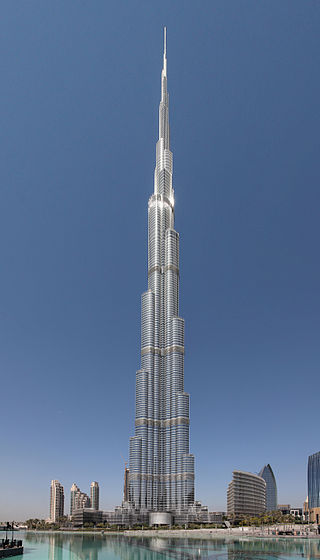
A skyscraper is a tall, continuously habitable building having multiple floors. Modern sources currently define skyscrapers as being at least 100 meters (330 ft) or 150 meters (490 ft) in height, though there is no universally accepted definition, other than being very tall high-rise buildings. Historically, the term first referred to buildings with between 10 and 20 stories when these types of buildings began to be constructed in the 1880s. Skyscrapers may host offices, hotels, residential spaces, and retail spaces.

The Hearst Tower is a building at the southwest corner of 57th Street and Eighth Avenue, near Columbus Circle, in the Midtown Manhattan neighborhood of New York City, United States. It is the world headquarters of media conglomerate Hearst Communications, housing many of its publications and communications companies. The Hearst Tower consists of two sections, with a total height of 597 feet (182 m) and 46 stories. The six lowest stories form the Hearst Magazine Building, designed by Joseph Urban and George B. Post & Sons, which was completed in 1928. Above it is the Hearst Tower addition, which was completed in 2006 and designed by Norman Foster.

Union Square is a commercial and residential real estate project in Hong Kong on the West Kowloon reclamation. Covering 13.54 hectares, the site has a gross floor area of 1,090,026 square metres (11,732,940 sq ft), approximately the size of the Canary Wharf development in London. As of 2011, the site contained some of the tallest buildings in Hong Kong — including the tallest commercial building in Hong Kong, the 118-storey International Commerce Centre and the loftiest residential tower in Hong Kong, The Cullinan.

Highcliff is a luxury apartment on a south slope of Happy Valley on the Hong Kong Island in Hong Kong. The 75-storey building's construction began in 2000 and was completed in 2003 under a design by DLN Architects & Engineers. It was the Silver Winner of the 2003 Emporis Skyscraper Award, coming in second to 30 St Mary Axe in London. The tower is the tallest "all"-residential building in Hong Kong island.
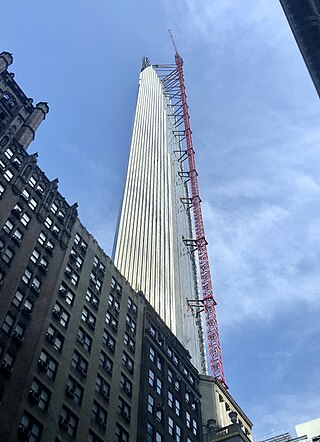
In architecture, the slenderness ratio, or simply slenderness, is an aspect ratio, the quotient between the height and the width of a building.

The Summit is a residential skyscraper located in upper Mid-Levels, Hong Kong. It is one of the tallest residential buildings in the city, standing at 220 metres (722 ft) tall, with 65 storeys. Construction of the building began in 1999 and it opened in 2001. Highcliff, another tall skyscraper, stands right next to this building.
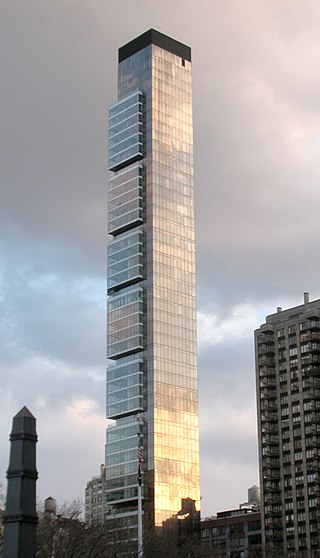
One Madison is a luxury residential condominium tower located on 23rd Street between Broadway and Park Avenue South, at the foot of Madison Avenue, across from Madison Square Park in the Flatiron District of Manhattan, New York City. The building's official address and main lobby entrance is at 23 East 22nd Street, rather than at 1 Madison Avenue; there is no public entrance on 23rd Street.

432 Park Avenue is a residential skyscraper at 57th Street and Park Avenue in Midtown Manhattan in New York City, overlooking Central Park. The 1,396-foot-tall (425.5 m) tower was developed by CIM Group and Harry B. Macklowe and designed by Rafael Viñoly. A part of Billionaires' Row, 432 Park Avenue has some of the most expensive residences in the city, with the median unit selling for tens of millions of dollars. At the time of its completion in 2015, 432 Park Avenue was the third-tallest building in the United States and the tallest residential building in the world. As of 2023, it is the sixth-tallest building in the United States, the fifth-tallest building in New York City, and the third-tallest residential building in the world.
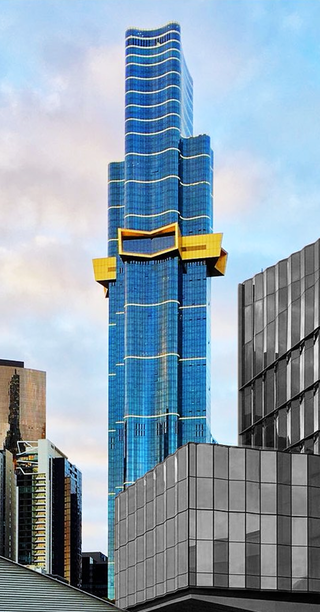
Australia 108 is a residential supertall skyscraper in the Southbank precinct of Melbourne, Victoria, Australia. Having officially topped out in June 2020, it became the tallest building in Australia by roof height, surpassing the Eureka Tower, and the second-tallest building in Australia by full height, surpassed by Q1 Tower.
111 West 57th Street, also known as Steinway Tower, is a supertall residential skyscraper in the Midtown Manhattan neighborhood of New York City. Developed by JDS Development Group and Property Markets Group, it is situated along Billionaires' Row on the north side of 57th Street near Sixth Avenue. The main portion of the building is an 84-story, 1,428-foot (435-meter) tower designed by SHoP Architects and completed in 2021. Preserved at the base is the 16-story Steinway Building, a former Steinway & Sons store designed by Warren and Wetmore and completed in 1925, which originally carried the address 111 West 57th Street.
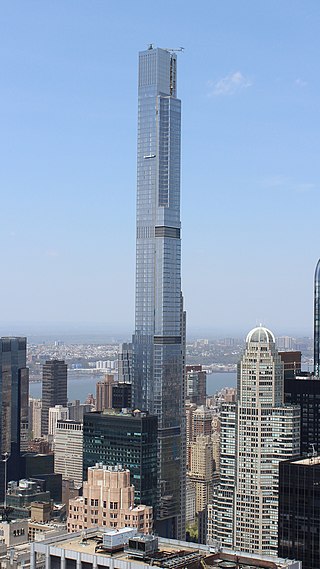
Central Park Tower is a residential supertall skyscraper at 225 West 57th Street in the Midtown Manhattan neighborhood of New York City, along Billionaires' Row. Designed by Adrian Smith + Gordon Gill Architecture, the building rises 1,550 feet (472.4 m) with 98 above-ground stories and three basement stories, although the top story is numbered 136. Central Park Tower is the second-tallest building in New York City, the United States, and the Western Hemisphere; the 15th tallest building in the world; the tallest primarily residential building in the world; and the tallest building outside Asia by roof height.

Elysium was a proposed residential skyscraper to be located in the Southbank precinct of Melbourne, Victoria, Australia. Despite receiving planning approval in 2013, the proposed skyscraper was scrapped in 2019.

4/C, also known as 4th & Columbia, is a proposed supertall skyscraper in Seattle, Washington, United States. If built, the 1,020-foot-tall (310 m), 91-story tower would be the tallest in Seattle, surpassing the neighboring Columbia Center, and the first supertall in the Pacific Northwest. The project has been under development by Miami-based Crescent Heights since 2015 and undergone several design changes and modifications under three architecture firms. As of 2023, 4/C is expected to have 1,090 residential units—apartments up to the 64th floor and condominiums from the 65th to 90th floor—along with several coworking and retail spaces. The latest version was designed by Skidmore, Owings & Merrill.

99 Hudson is a 79-story condominium in Jersey City, New Jersey. It is the tallest building in Jersey City and the state of New Jersey, and the 46th tallest building in the United States. It is also the tallest residential building in the United States outside of New York City and Chicago. Developed by China Overseas America, 99 Hudson is the first residential project in the U.S. for the firm. The 1.4 million square-foot building will include 781 condominium units ranging from studios to three bedrooms.
45 Broad Street is a 68-story, 1,039-foot (317-meter) supertall residential skyscraper being constructed in the Financial District of Manhattan, New York City. The building will become Lower Manhattan's tallest residential tower. Excavation started in 2017, but as of 2020, construction is on hold.

















